Clownfish, the vibrant darlings of the aquarium world, captivate reefers from novices to connoisseurs. Their alluring appearance and low-maintenance nature make them an irresistible addition to any saltwater haven.
With a vast array of subcategories, the Clownfish species boasts both popular favorites and elusive rarities. Some reef enthusiasts crave petite varieties, while others seek out striking patterns. From hobbyists to seasoned Fishkeepers, many are even willing to splurge on these aquatic jewels.
Join us on a vivid journey as we explore the diverse world of Clownfish from A to Z. Dive in and discover the perfect finned star to grace your underwater stage!
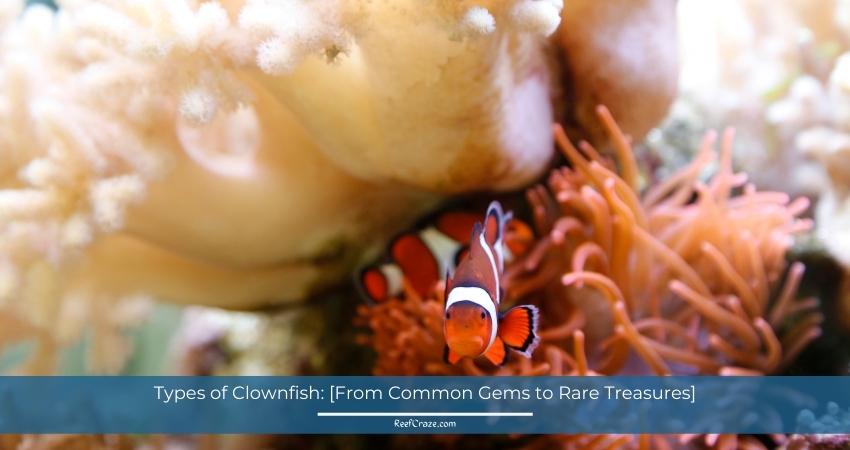
How Many Clownfish Species Are There?
So far, a total of 30 Clownfish species have been recognized. Most originate from the warmer water regions of the Read Sea, the western Pacific, and the Indian Ocean. Their natural habitat does not include the Mediterranean, Caribbean, and Atlantic Oceans.
The Orange Clownfish usually refers to 2 common types from all 30: Amphiprion ocellaris and Amphiprion percula. The latter differs from the first one with its bright orange body with white bands featuring a black outline.
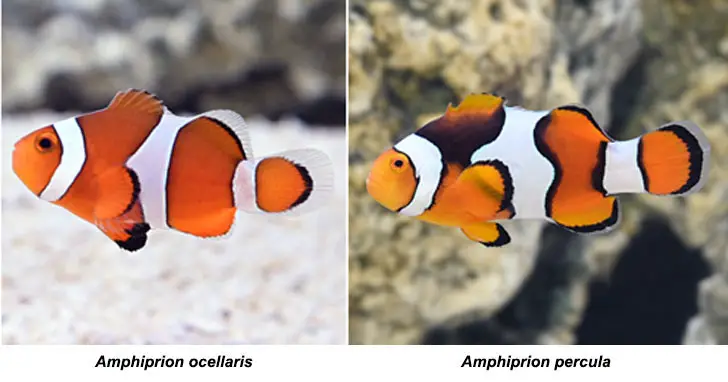
Related Article: How Much Does A Clownfish Cost
Types of Clownfish: Most Popular And Rare Varieties For Aquarium
I will discuss 6 Clownfish types. Have a look at them before going down to their profiles.
- Most expensive Clownfish: Peacekeeper Maroon Clownfish
- Smallest Clownfish: True or Orange Percula Clownfish
- Designer Clownfish: Midnight Clownfish
- Rare Clownfish: Picasso Clownfish
- Most popular Clownfish: Ocellaris Clownfish
When reading about them in detail, you will see that a Clown belonging to a specific type also falls under a different one. For example, the most expensive species, the Peacekeeper Maroon Clownfish, is also a designer Clown. If you are into both Clownfish types, the 2-in-1 one will suit you well.
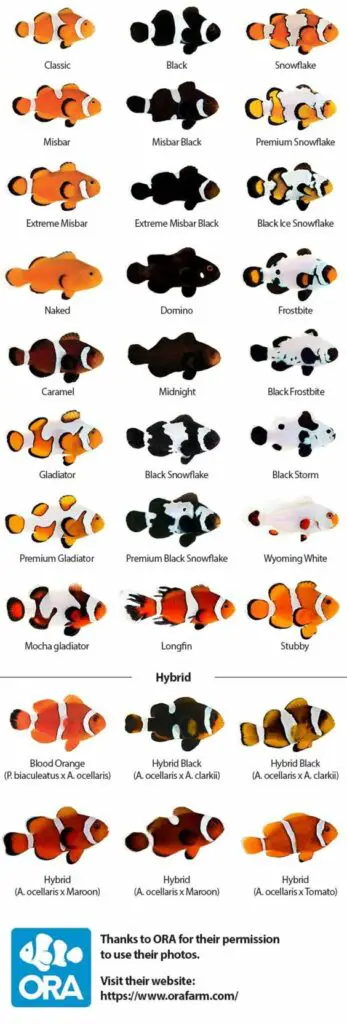
1. Most Popular Clownfish Species: The Ocellaris Clownfish (Amphiprion Ocellaris)
Who doesn’t know of the Ocellaris Clownfish? We all saw it in the Finding Nemo movie, right? It has other names, like Common Clownfish, Clown Anemonefish, and False Percula Clownfish. The last name is due to its resemblance to the Percula fish. You can distinguish it by its dark color around the eyes with thinner black borders around the white bands.
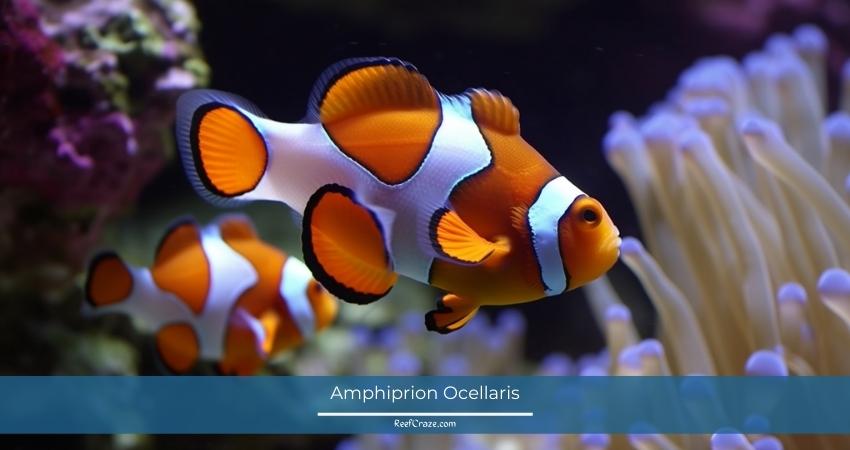
It is the most common saltwater tank fish to pet, also great for beginners with small aquariums. Plus, they are 100% reef-safe and harmless for your corals.
Origin
Origins of the famous Orange fish include the Western Pacific Ocean and the Eastern Indian Ocean. However, most Clownfish you see today are bred in captivity. When buying one, ask about its original habitat and get a captive-bred one when possible.
Colors And Appearance
There are multiple color combinations of this fish available through captive breeding. It welcomes a Sea Anemone as its host, but a host is not mandatory for survival.
The traditional pattern includes a full-orange body with fins tipped with black and white and three black-edged white bands around the tail peduncle, midbody, and back of the head. Additional combinations have full-white or full-black bodies with various white spots in the current pet trade. Depending on genetics, the orange coloration can vary from a deep orange-red or orange-brownish to a light orange tone.
Temperament And Diet
Clownfish is very good-natured with different inverts and fish. It is the friendliest with Yellow Tang, Pacific Blue Tang, and Blue-Green Chromis. Larger and more aggressive fish can intimidate and harass your Clowns. So be careful while choosing their tank mates.
Omnivorous, it can eat a combo of veggies and meat. You can feed it fleshy treats like mysis and brine shrimps with algae and raw veggies. Preparing a mixed diet is necessary to nourish a saltwater fish.
Living in the shallow eater, it has a non-stop churning metabolism. So it is best to feed them in small portions multiple times a day to help with their digestion.
2. Most Expensive Clownfish Species: Peacekeeper Maroon Clownfish (Premnas Biaculeatus)
Fishkeepers sometimes categorize the Peacekeeper Maroon Clownfish as a designer Clownfish because of its appearance. It has a uniquely colored head decorated with a mask-type pattern, accompanied by a distinct striping with framed bold markings here and there.
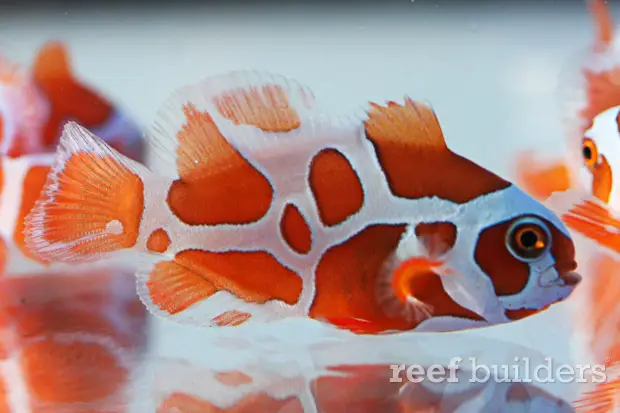
Origin
The combination of such striping and colors is one of a kind in the Clownfish family, as it is scientifically bred in captivity to get the stunning look. It is the result of an amalgamation of lab-crafted breeding strategies. Hundreds and thousands of juvenile Clownfish will produce a handful of Peacekeepers with the desirable aesthetic physical features.
So how much do you have to spend to get one? $9000! Yes! There you have the most expensive Clownfish species for your aquarium.
Although the Peacekeeper is captivity-bred, the original Maroon Clownfish have their natural habitat in the Indo-Pacific ocean, stretching from Western Indonesia to the Great Barrier Reef and Taiwan.
Gender
Hermaphrodite, like others in their community, the Peacekeeper Clownfish live in a hierarchy of female domination that prioritizes size over other characteristics. Although territorial, they are usually sociable.
Diet
A Peacekeeper’s diet comprises copepods, algae, marine worms, crustaceans, and phytoplankton. You should feed them twice a day.
Temperament And Tank Mates
Maroon Clownfish is typically a resilient and hardy species, but its Peacekeeper subcategory is comparatively delicate. As their life begins in captivity, there are uncertainties about their tolerance for broad ranges of water variables. Scientists cannot confirm if that trait is automatically ingrained in them like the others.
Considering the aggressive temperament of the fish, its name sounds pretty ironic. Maroon Clownfish are one of the least peaceful Clownfish. Sometimes they become so vile that they even attack their owner’s hand while they clean the aquarium.
Their territorial characteristics also make them hostile towards small and gentle fish, including Clownfish. So you should keep them with fish having similar temperaments. Some suitable tank mates are Triggers, Wrasses, Tangs, and Angelfish.
3. Smallest Clownfish Species: True Or Orange Percula Clownfish (Amphiprion Percula)
The True or Orange Percula is the smallest Clownfish. It becomes only 3 inches when completely grown, which makes it adorable and different from other Clowns, not to mention a must-have for many aquarists.
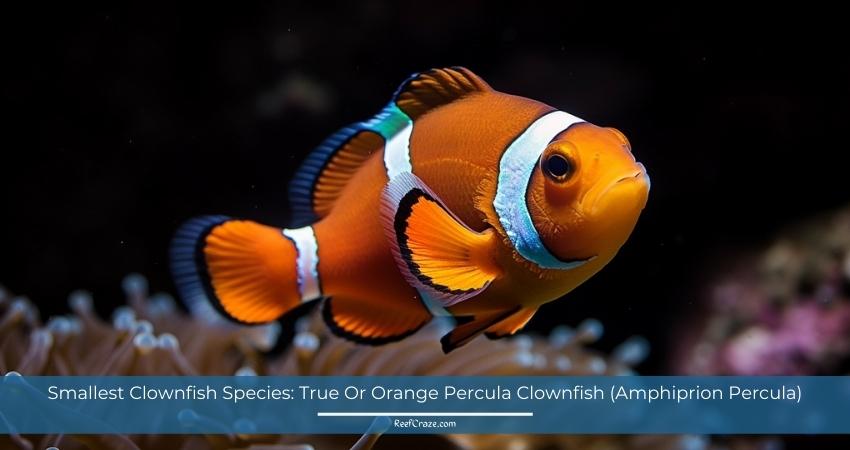
Apart from its cute size, it is famous for its white marks contrasted with its orange appearance. Varieties of the Orange Percula are available, commonly the Picasso Percula.
Temperament
It is a peaceful-natured fish with less territorial aggression. However, that, coupled with its size, makes it vulnerable to other large and hostile fishes. So make lots of hiding spots in your aquarium for the Percula and pick its companions carefully.
Diet
Since the Orange Clown is an omnivore, you can feed it copepods, larval tunicates, and planktonic algae. It will also eat the remnants of its host anemone’s prey and the anemone’s dead tentacles.
Tank Size And Lifespan
If you adopt a single Percula, you can easily keep it in a 10-gallon tank. However, you will need at least a 20-gallon home for two. The tank size will change according to the number of fish.
The size may have you doubt its life expectancy, but do not let it fool you. Provided the maintenance is up to the mark, it can live for around 2 decades in a reef aquarium.
4. Designer Clownfish Species: Midnight Clownfish (Amphiprion Ocellaris)
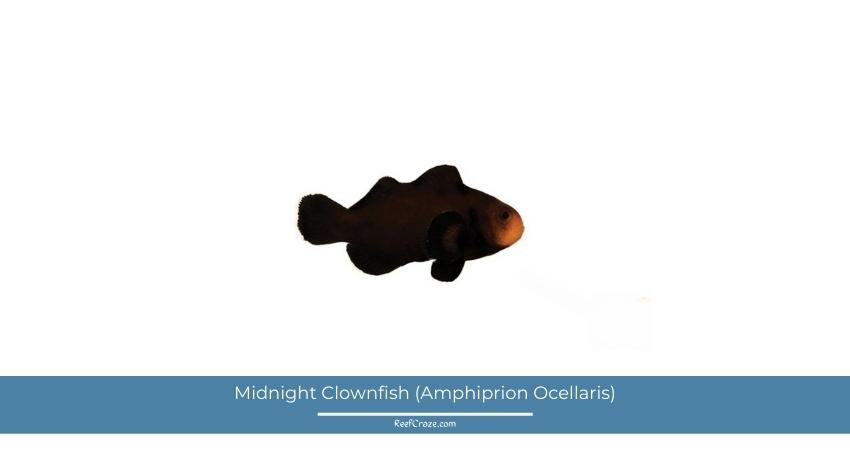
A Designer Clownfish refers to one with different looks from any common Clownfish, bred for unusual patterns, stripe differences, color variations, and shape differences. Anyone will do a double take after spotting it in an aquarium abundant with fish. Common designer Clownfish types involve Phantom Clownfish, Naked Clownfish, Midnight Clownfish, Snowflake Clownfish, and Lightning Maroon Clownfish.
Colors And Appearance
The Midnight Clownfish is a Black Ocellaris Clownfish minus stripes. It has similarities with the Naked Clownfish, being a black alteration.
It is brownish during its early juvenile phase, developing a deep black color as growing and maturing. It has brown spots around its face, the last to become black. It is undeniably an extraordinary and gorgeous-looking fish that makes an excellent pet in a reef tank.
Diet
Like other omnivorous Ocellaris Clownfish, the Midnight Clown’s diet combines amphipods, copepods, and its host anemone’s leftover food. The captive-bred fish also eats different aquarium foods, like flake food, pellets, frozen brine shrimps, and frozen Mysis shrimps.
Host Anemone
The captive and temperament maintenance of a Midnight Clownfish has a lot in common with that of a typical Ocellaris Clownfish. Sturdy and gentle, it thrives in a saltwater aquarium with an anemone and also without it.
If you want to have a host anemone for it, you can choose one among many because it accepts different anemone types. Many reefers prefer the Bubble Tip Anemone. You can check out others that regular Clownfishes get along with, i.e., Merten’s Carpet Sea Anemone, Giant Carpet Sea Anemone, Magnificent Sea Anemone, etc.
Maintenance And Others
Caring for the Midnight black beauty is easy, even for beginners. You will need a 10-gallon aquarium to house one. Depending on your tank size, it will be compatible with other Clowns. Bear in mind the size of its tank mates, though, because they can intimidate and harass the mini-sized fish at any time.
Note that this designer fish, Midnight Clownfish, grows only up to 3 inches. That means it falls under the smallest Clownfish category too. Anyone looking for a teeny-tiny striking Clown must consider it.
5. Rare Clownfish Species: Picasso Clownfish (Amphiprion Percula)
The Picasso Clownfish, with a deep orange body like most Clownfish, may not look that different at first sight. But its uniqueness is in its black and white bands, presenting a touch of art in your reef tank.
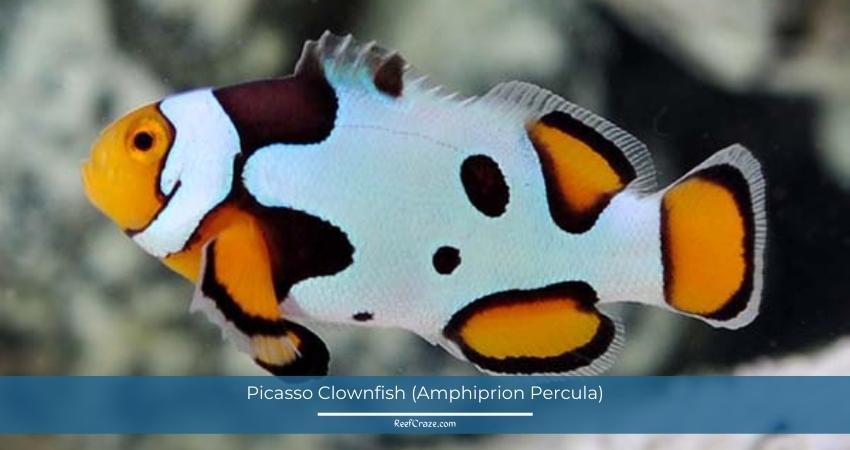
Colors And Appearance
Its stripes do not have a fixed formation. They appear in scattered patches of solid white bordered with black marks. Sometimes its other variations contain different color combinations, i.e., a full-white body with black lines surrounding orange patches. The exact opposite specimen is also available, giving you a bittersweet confusion of choosing the more attractive one.
Origin
The natural variant of the fish usually occurs in Papua New Guinea and the Solomon Islands. As it is exceptionally scarce, it is bred in captivity too, where juvenile Picassos often take longer to develop the striking black part. It does not appear until they reach maturity.
Others
Picasso Clownfish is a small fish that hardly grows above 3 inches. Nonetheless, its price will surely make up for its tininess. It is one of the priciest Clownfish types because of its rarity. So, you can consider it as an expensive, tiny, rare, and designer Clownfish altogether.
Its temperament, diet, feeding, caring, and other upkeep requirements are the same as Midnight Clownfish. You can easily keep a couple of happy Picassos in a 30-gallon aquarium and expect them to accompany you for at least 10 years.
Final Words
The one uniform fact found in each Clownfish type is that they all are marvelously cute. However, since fish collecting is a passion and a form of love for fish, it is only expected that reefers will have specific choices for their reef tanks.
There are 6 Clownfishes from 6 popular categories sought after by all reefers. Now, when choosing a suitable one, consider your aquarium size, preferred Clown’s maintenance, diet, and tank mates. That is because although they are from the same family, their maintenance is different.
Once you fulfill all the initial requirements, get ready to bond and spend delightful times with your little water buddy!
